run flat Lexus IS F 2011 Owner's Manual
[x] Cancel search | Manufacturer: LEXUS, Model Year: 2011, Model line: IS F, Model: Lexus IS F 2011Pages: 529, PDF Size: 13.89 MB
Page 5 of 529

1
2
3
4
5
6
IS F_EE
5
3-7. Other interior features
Sun visors ........................... 330
Vanity mirrors .................... 331
Clock .................................. 332
Satellite switches ................ 333
Ashtrays ............................. 336
Cigarette lighter.................. 337
Power outlet ....................... 338
Seat heaters ........................ 339
Armrest............................... 341
Trunk storage extension ..... 342
Coat hooks.......................... 344
Floor mat ............................ 345
Trunk features .................... 3464-1. Maintenance and care
Cleaning and protecting the
vehicle exterior................. 350
Cleaning and protecting the
vehicle interior ................. 353
4-2. Maintenance
Maintenance requirements . 356
4-3. Do-it-yourself maintenance
Do-it-yourself service
precautions ....................... 359
Hood ................................... 362
Positioning a floor jack ...... 363
Engine compartment .......... 365
Tires ................................... 378
Tire inflation pressure ........ 381
Wheels................................ 383
Air conditioning filter ........ 385
Electronic key battery ........ 388
Checking and replacing
fuses ................................. 390
Light bulbs ......................... 404
4Maintenance and care
Page 9 of 529
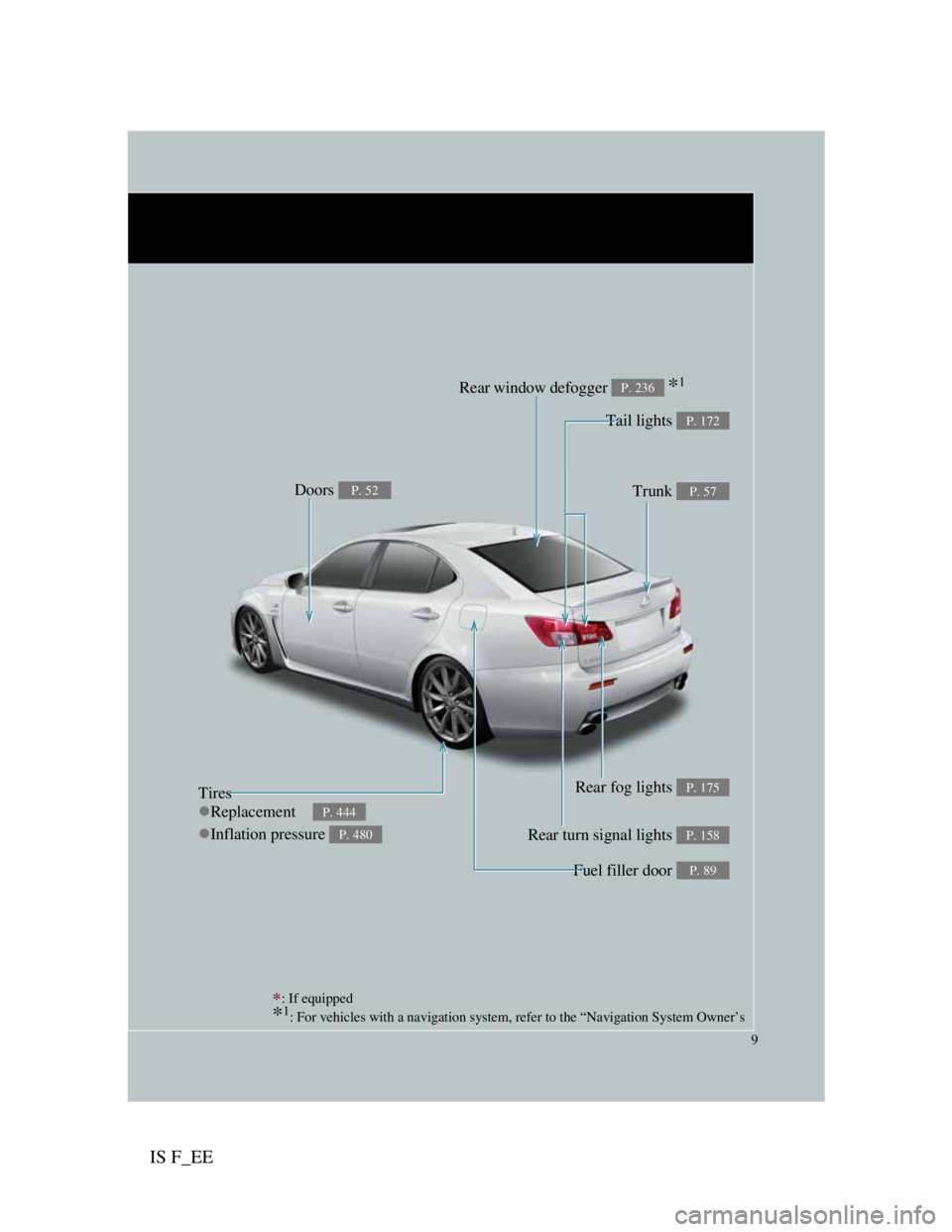
IS F_EE
9
Tires
Replacement
Inflation pressure
P. 444
P. 480
Tail lights P. 172
Rear window defogger *1P. 236
Trunk P. 57Doors P. 52
Fuel filler door P. 89
Rear turn signal lights P. 158
Rear fog lights P. 175
: If equipped
*1: For vehicles with a navigation system, refer to the “Navigation System Owner’s
Page 131 of 529

123
1-7. Safety information
1
Before driving
IS F_EE
CAUTION
Child restraint precautions
Never use a rear-facing child restraint system on the front passenger seat
when the airbag manual on-off switch is on. (P. 135)
In the event of an accident, the force of the rapid inflation of the front pas-
senger airbag can cause death or serious injury to the child.
A forward-facing child restraint system may be installed on the front pas-
senger seat only when it is unavoidable. Always move the seat as far back
as possible, because the front passenger airbag could inflate with consid-
erable speed and force. Otherwise, the child may be killed or seriously
injured.
Do not allow the child to lean his/her head or any part of his/her body
against the door or the area of the seat, front pillar, rear pillar or roof side
rail from which the side airbags or curtain shield airbags deploy even if
the child is seated in the child restraint system. It is dangerous if the side
airbags and curtain shield airbags inflate, and the impact could cause
death or serious injury to the child.
Make sure you have complied with all installation instructions provided
by the child restraint manufacturer and that the system is properly
secured. If it is not secured properly, it may cause death or serious injury
to the child in the event of a sudden stop, sudden swerve or an accident.
When children are in the vehicle
Do not allow children to play with the seat belt. If the seat belt becomes
twisted around a child’s neck, it may lead to choking or other serious inju-
ries that could result in death.
If this occurs and the buckle cannot be unfastened, scissors should be used
to cut the belt.
When the child restraint system is not in use
Keep the child restraint system properly secured on the seat even if it is
not in use. Do not store the restraint unsecured in the passenger compart-
ment.
If it is necessary to detach the child restraint system, remove it from the
vehicle or store it securely in the trunk. This will prevent it from injuring
passengers in the event of a sudden stop, sudden swerve or an accident.
Page 440 of 529

5
417
5-1. Essential information
When trouble arises
IS F_EE
If your vehicle needs to be towed
Before towing
The following may indicate a problem with your transmission.
Contact any authorized Lexus dealer or repairer, or another duly
qualified and equipped professional, before towing.
The engine is running, but the vehicle will not move.
The vehicle makes an abnormal sound.
Emergency towing
If a tow truck is not available, in an emergency your vehicle may
be temporarily towed using a cable or chain secured to the emer-
gency towing eyelet. This should only be attempted on hard, sur-
faced roads for short distances at low speeds.
A driver must be in the vehicle to steer and operate the brakes. The
vehicle’s wheels, drive train, axles, steering and brakes must be in
good condition.
If towing is necessary, we recommend having your vehicle towed by
any authorized Lexus dealer or repairer, or another duly qualified and
equipped professional, such as a commercial towing service, using a
lift-type truck or a flat bed truck.
Use a safety chain system for all towing, and abide by all state/provin-
cial and local laws.
If towing from the rear, the vehicle's front wheels and axles must be in
good condition. (P. 421)
If they are damaged, use a towing dolly or flat bed truck.
Page 446 of 529

5
423
5-1. Essential information
When trouble arises
IS F_EE
If you think something is wrong
If you notice any of the following symptoms, your vehicle probably
needs adjustment or repair. Contact any authorized Lexus dealer or
repairer, or another duly qualified and equipped professional, as soon
as possible.
Visible symptoms
Fluid leaks under the vehicle
(Water dripping from the air conditioning after use is nor-
mal.)
Flat-looking tires or uneven tire wear
Engine coolant temperature gauge needle continually points
higher than normal
Audible symptoms
Changes in exhaust sound
Excessive tire squeal when cornering
Strange noises related to the suspension system
Pinging or other noises related to the engine
Operational symptoms
Engine missing, stumbling or running rough
Appreciable loss of power
Vehicle pulls heavily to one side when braking
Vehicle pulls heavily to one side when driving on a level
road
Page 474 of 529
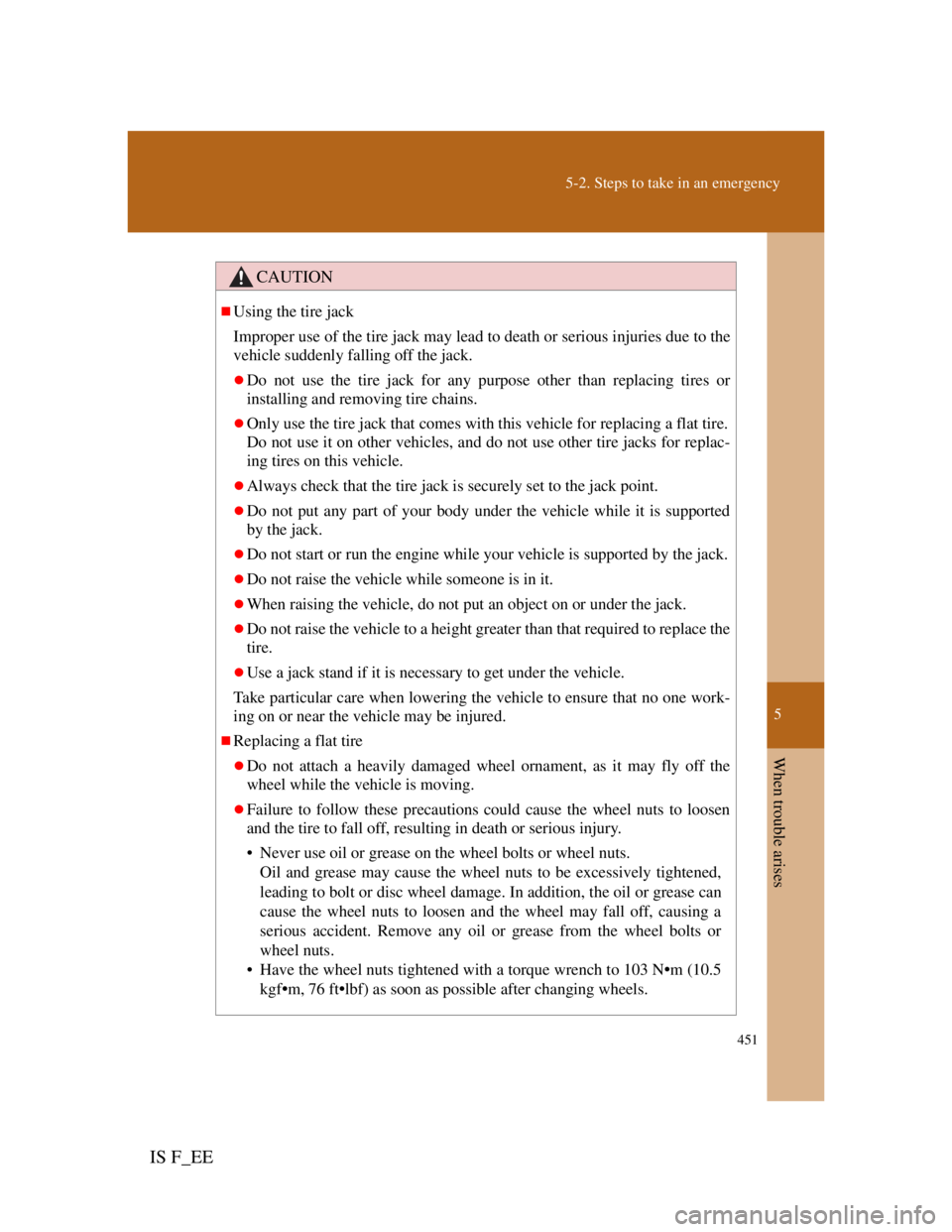
5
451
5-2. Steps to take in an emergency
When trouble arises
IS F_EE
CAUTION
Using the tire jack
Improper use of the tire jack may lead to death or serious injuries due to the
vehicle suddenly falling off the jack.
Do not use the tire jack for any purpose other than replacing tires or
installing and removing tire chains.
Only use the tire jack that comes with this vehicle for replacing a flat tire.
Do not use it on other vehicles, and do not use other tire jacks for replac-
ing tires on this vehicle.
Always check that the tire jack is securely set to the jack point.
Do not put any part of your body under the vehicle while it is supported
by the jack.
Do not start or run the engine while your vehicle is supported by the jack.
Do not raise the vehicle while someone is in it.
When raising the vehicle, do not put an object on or under the jack.
Do not raise the vehicle to a height greater than that required to replace the
tire.
Use a jack stand if it is necessary to get under the vehicle.
Take particular care when lowering the vehicle to ensure that no one work-
ing on or near the vehicle may be injured.
Replacing a flat tire
Do not attach a heavily damaged wheel ornament, as it may fly off the
wheel while the vehicle is moving.
Failure to follow these precautions could cause the wheel nuts to loosen
and the tire to fall off, resulting in death or serious injury.
• Never use oil or grease on the wheel bolts or wheel nuts.
Oil and grease may cause the wheel nuts to be excessively tightened,
leading to bolt or disc wheel damage. In addition, the oil or grease can
cause the wheel nuts to loosen and the wheel may fall off, causing a
serious accident. Remove any oil or grease from the wheel bolts or
wheel nuts.
• Have the wheel nuts tightened with a torque wrench to 103 N
•m (10.5
kgf
•m, 76 ft•lbf) as soon as possible after changing wheels.
Page 523 of 529
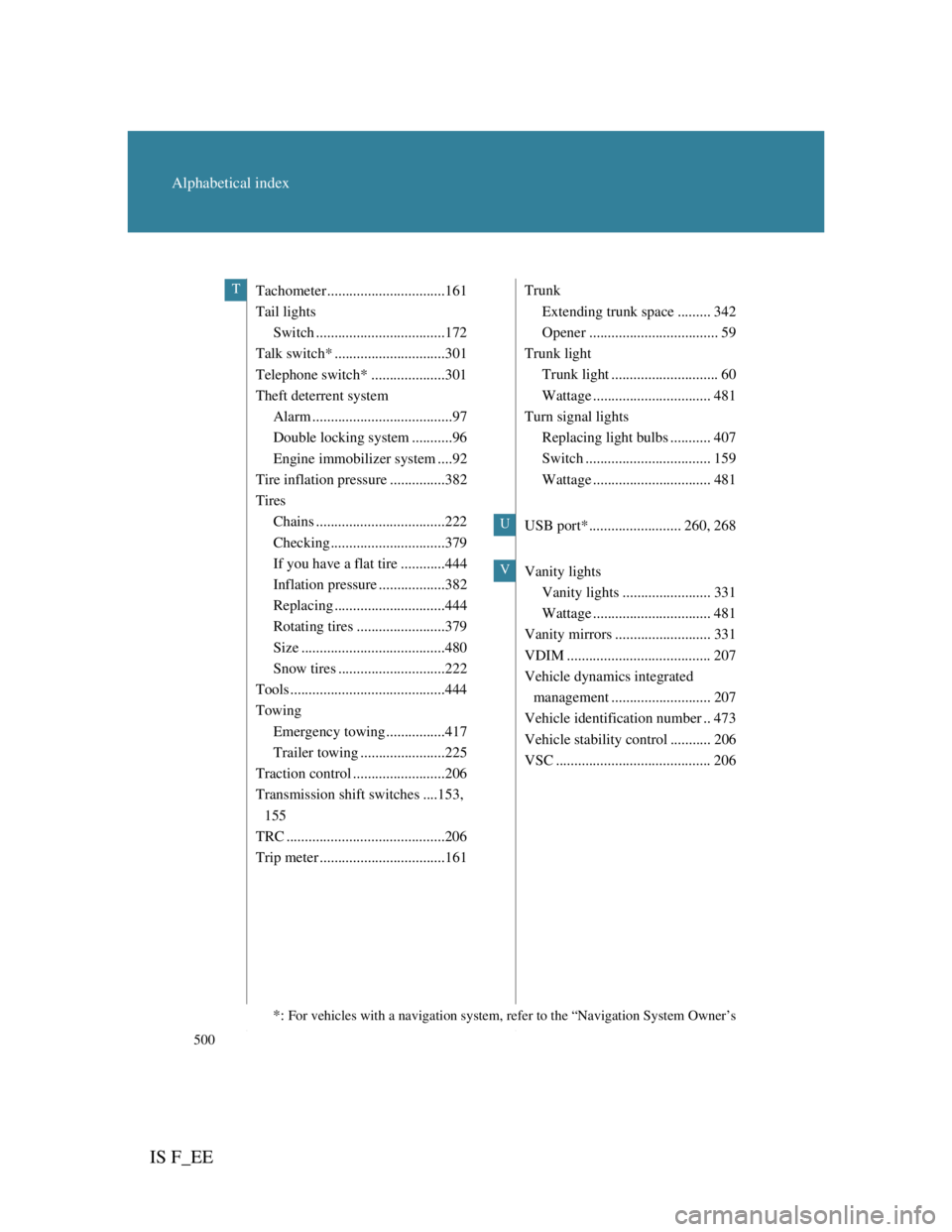
500
Alphabetical index
IS F_EE
Tachometer ................................161
Tail lights
Switch ...................................172
Talk switch* ..............................301
Telephone switch* ....................301
Theft deterrent system
Alarm ......................................97
Double locking system ...........96
Engine immobilizer system ....92
Tire inflation pressure ...............382
Tires
Chains ...................................222
Checking ...............................379
If you have a flat tire ............444
Inflation pressure ..................382
Replacing ..............................444
Rotating tires ........................379
Size .......................................480
Snow tires .............................222
Tools ..........................................444
Towing
Emergency towing ................417
Trailer towing .......................225
Traction control .........................206
Transmission shift switches ....153,
155
TRC ...........................................206
Trip meter ..................................161Trunk
Extending trunk space ......... 342
Opener ................................... 59
Trunk light
Trunk light ............................. 60
Wattage ................................ 481
Turn signal lights
Replacing light bulbs ........... 407
Switch .................................. 159
Wattage ................................ 481
USB port* ......................... 260, 268
Vanity lights
Vanity lights ........................ 331
Wattage ................................ 481
Vanity mirrors .......................... 331
VDIM ....................................... 207
Vehicle dynamics integrated
management ........................... 207
Vehicle identification number .. 473
Vehicle stability control ........... 206
VSC .......................................... 206T
*: For vehicles with a navigation system, refer to the “Navigation System Owner’s
U
V
Page 527 of 529
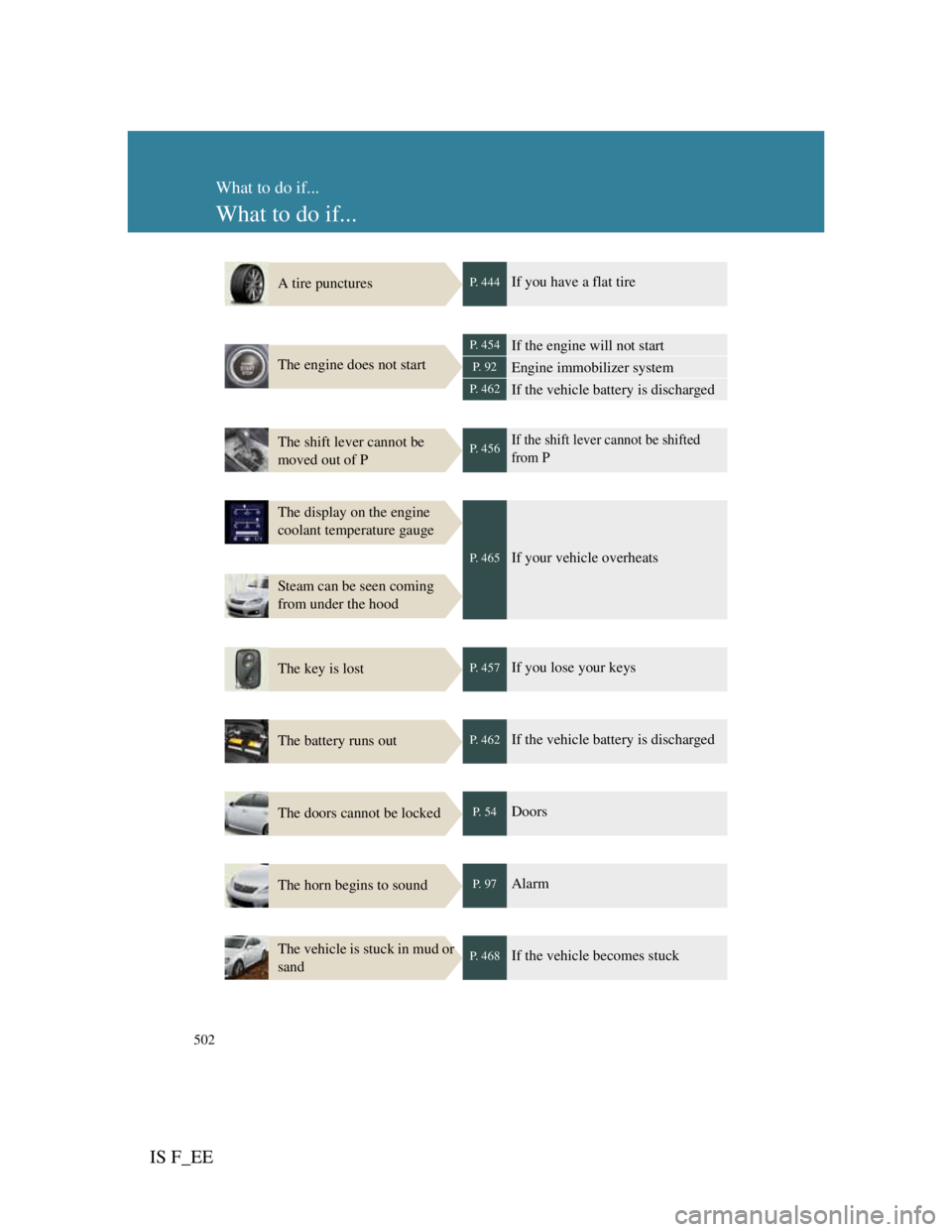
502
IS F_EE
What to do if...
What to do if...
A tire puncturesP. 444If you have a flat tire
The engine does not start
P. 454If the engine will not start
P. 9 2Engine immobilizer system
P. 462If the vehicle battery is discharged
The shift lever cannot be
moved out of PP. 456If the shift lever cannot be shifted
from P
The display on the engine
coolant temperature gauge
Steam can be seen coming
from under the hood
P. 465If your vehicle overheats
The key is lostP. 457If you lose your keys
The battery runs outP. 462If the vehicle battery is discharged
The doors cannot be lockedP. 5 4Doors
The horn begins to soundP. 9 7Alarm
The vehicle is stuck in mud or
sandP. 468If the vehicle becomes stuck
Page 529 of 529
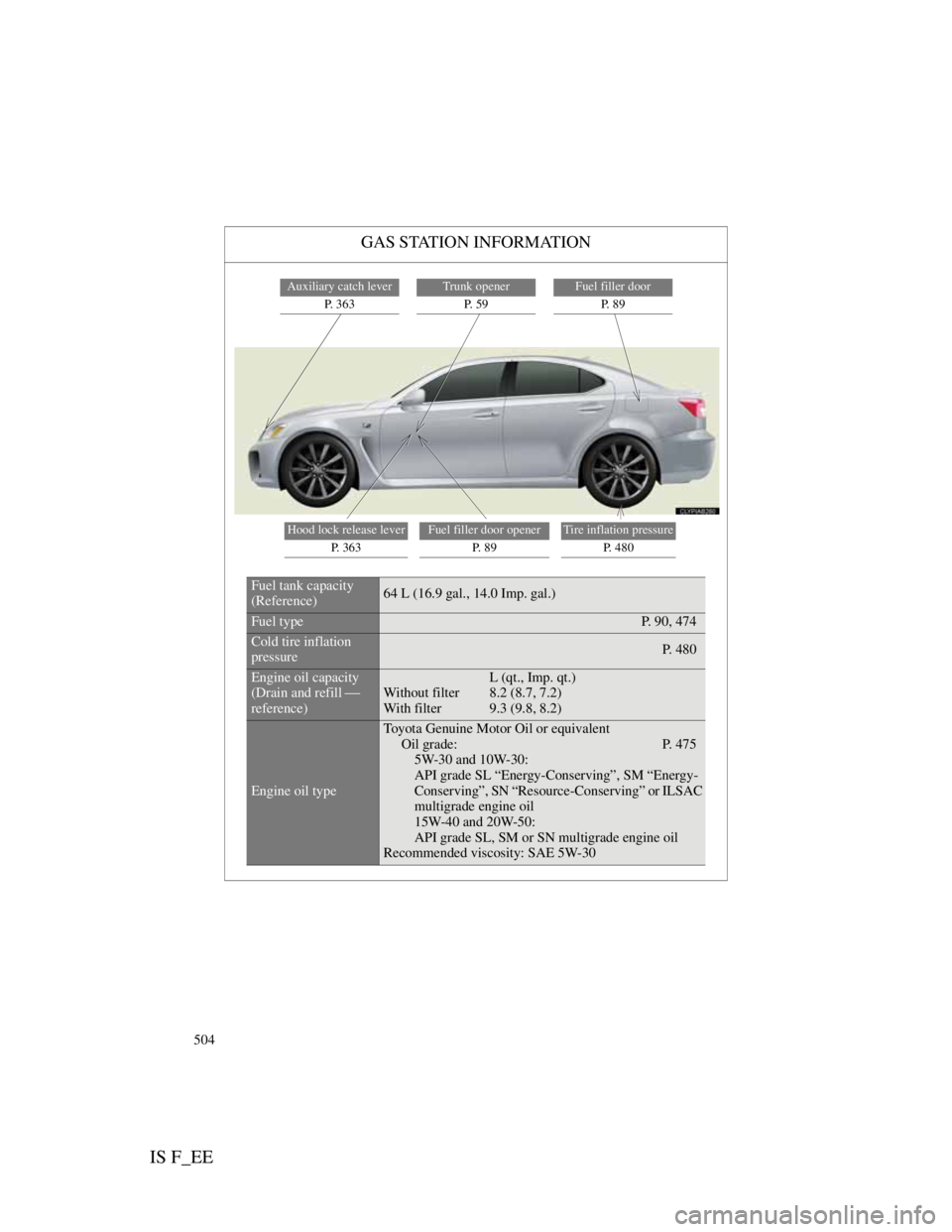
504
IS F_EE
GAS STATION INFORMATION
Auxiliary catch lever
P. 363Trunk opener
P. 5 9Fuel filler door
P. 8 9
Hood lock release lever
P. 3 6 3Fuel filler door opener
P. 8 9Tire inflation pressure
P. 4 8 0
Fuel tank capacity
(Reference)64 L (16.9 gal., 14.0 Imp. gal.)
Fuel typeP. 90, 474
Cold tire inflation
pressureP. 480
Engine oil capacity
(Drain and refill
reference)L (qt., Imp. qt.)
Without filter 8.2 (8.7, 7.2)
With filter 9.3 (9.8, 8.2)
Engine oil type
Toyota Genuine Motor Oil or equivalent
Oil grade: P. 475
5W-30 and 10W-30:
API grade SL “Energy-Conserving”, SM “Energy-
Conserving”, SN “Resource-Conserving” or ILSAC
multigrade engine oil
15W-40 and 20W-50:
API grade SL, SM or SN multigrade engine oil
Recommended viscosity: SAE 5W-30